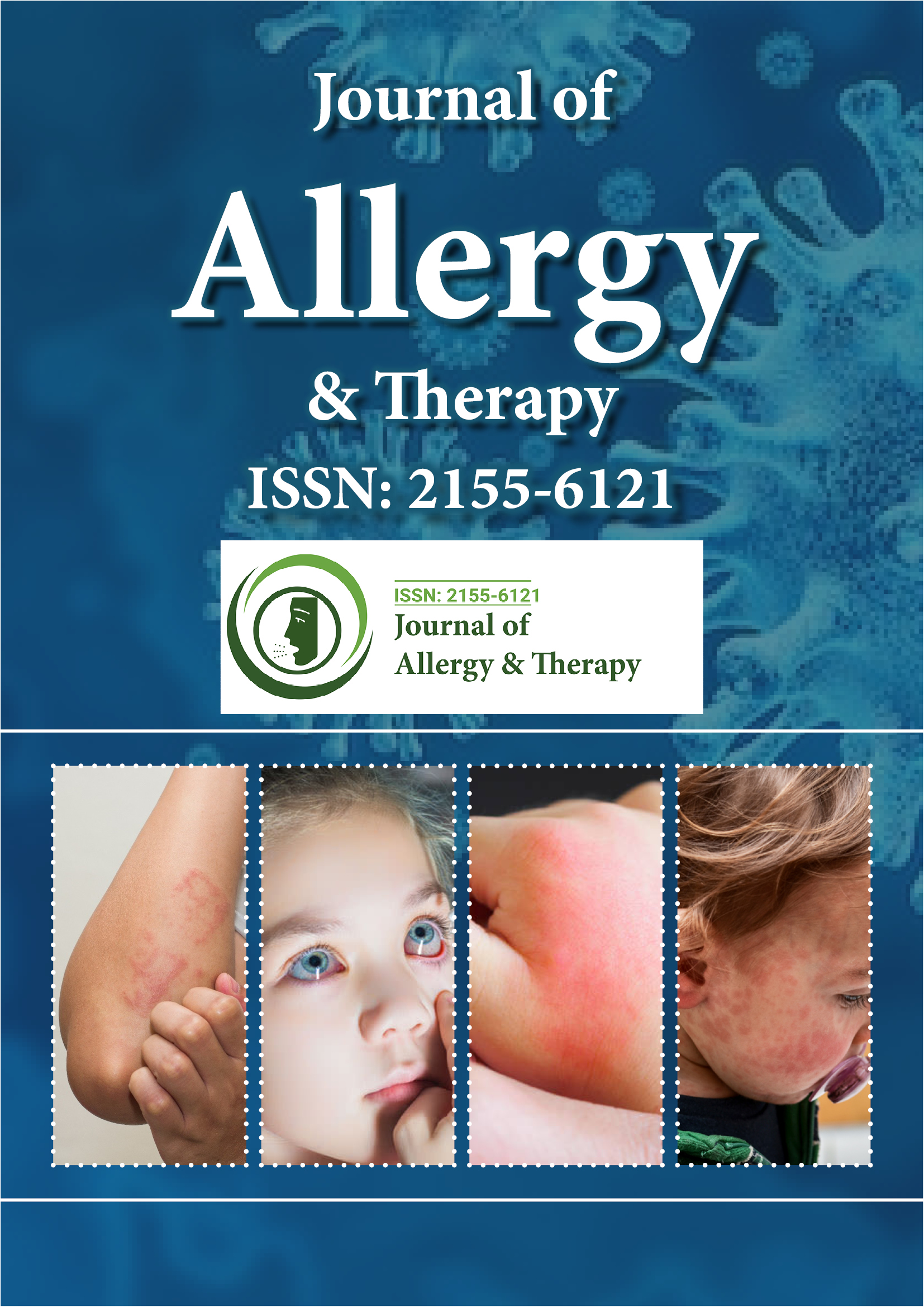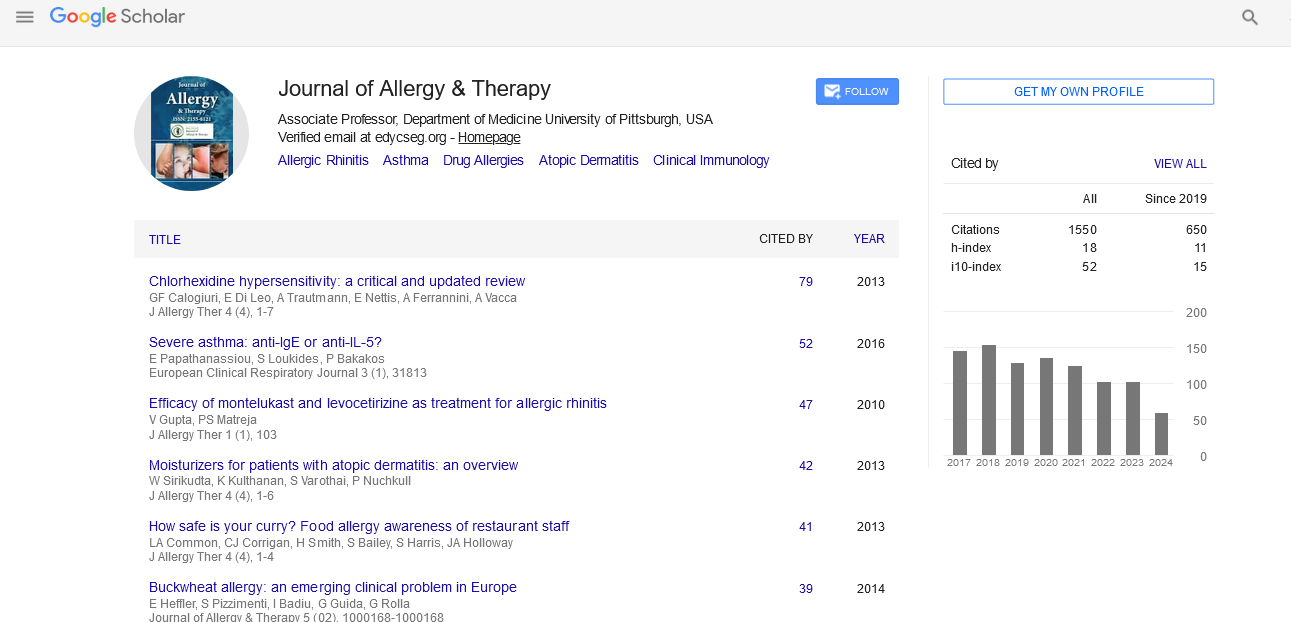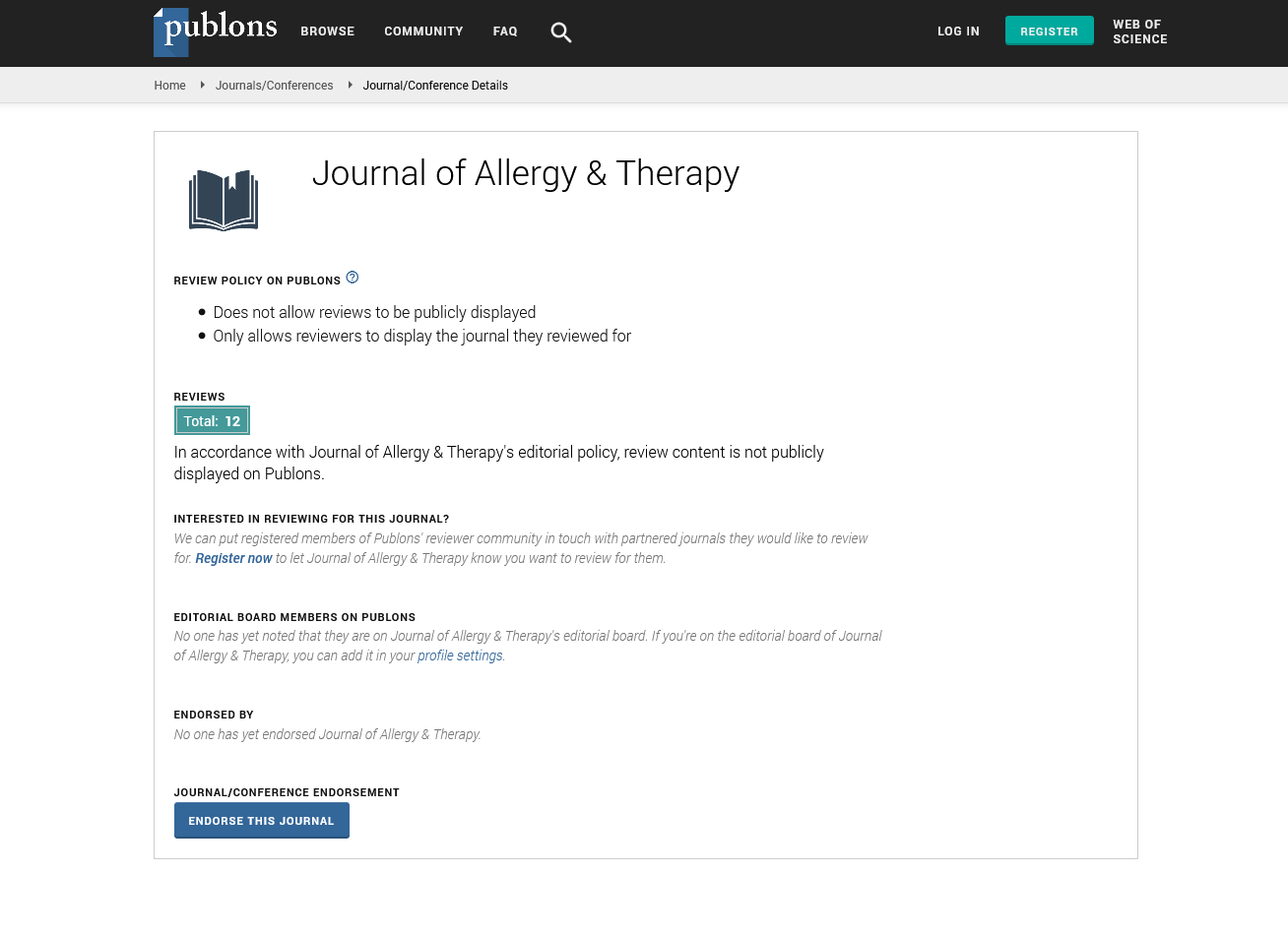Indexed In
- Academic Journals Database
- Open J Gate
- Genamics JournalSeek
- Academic Keys
- JournalTOCs
- China National Knowledge Infrastructure (CNKI)
- Ulrich's Periodicals Directory
- Electronic Journals Library
- RefSeek
- Hamdard University
- EBSCO A-Z
- OCLC- WorldCat
- SWB online catalog
- Virtual Library of Biology (vifabio)
- Publons
- Geneva Foundation for Medical Education and Research
- Euro Pub
- Google Scholar
Useful Links
Share This Page
Journal Flyer

Open Access Journals
- Agri and Aquaculture
- Biochemistry
- Bioinformatics & Systems Biology
- Business & Management
- Chemistry
- Clinical Sciences
- Engineering
- Food & Nutrition
- General Science
- Genetics & Molecular Biology
- Immunology & Microbiology
- Medical Sciences
- Neuroscience & Psychology
- Nursing & Health Care
- Pharmaceutical Sciences
Short Communication - (2022) Volume 13, Issue 2
Current Understanding of Severe Cutaneous Adverse Reaction (SCAR)
Debdeep Mitra*Received: 07-Feb-2022, Manuscript No. JAT-22-15491; Editor assigned: 09-Feb-2022, Pre QC No. JAT-22-15491(PQ); Reviewed: 23-Feb-2022, QC No. JAT-22-15491; Revised: 25-Feb-2022, Manuscript No. JAT-22-15491(R); Published: 04-Mar-2022, DOI: 10.35248/2155-6121.22.13.271
Description
Severe Cutaneous Adverse Reaction (SCAR) is a rare but life- threatening emergency. It encompasses a spectrum of Stevens- Johnson Syndrome/Toxic Epidermal Necrolysis (SJS/TEN), Acute Generalized Exanthematous Pustulosis (AGEP), Drug Reaction with Eosinophilia and Systemic Symptoms (DRESS), and Generalized Bullous Fixed Drug Eruptions (GBFDE) [1]. All of them have a common presentation of extensive skin eruptions induced by drug intake. SCAR to drugs is associated with intensive care management, long term morbidity, health care costs, multi-disciplinary care and high mortality rates [2]. The incidence of SCAR is difficult to assess due to its rarity but the incidence of DRESS syndrome in new users of antiepileptic drugs has been estimated to be around one per 1000 and the incidence of SJS/TEN is estimated to be around two per 1 million people [3] Although rare, but high index of suspicion and adequate knowledge among physicians is the key to early diagnosis, prompt stoppage of the offending drug and timely initiation of definitive care. The key clinical and histopathology features of the major subsets of SCAR are shown in Table 1.
| Drug to rash interval | Systemic features | Skin findings | Laboratory parameters | Organs involved | Histopathology features | |
|---|---|---|---|---|---|---|
| SJS=Stevens-Johnson Syndrome TEN=Toxic Epidermal Necrolysis |
4 days to 4 weeks | Fever, sore throat | Skin detachment (less than 10% in SJS, 10-30% in SJS-TEN overlap, more than 30% in TEN), hemorrhagic crusting of mucosa, positive Nikolsky sign, Bullous lesions and purpura | Eosinophilia, renal and hepatic impairment, transitory neutropenia | Skin (acute skin failure), mucosae, respiratory tract, liver, kidney | Full thickness epidermal necrolysis, necrotic keratinocytes, mixed dermal infiltrate, dermal oedema, negative Direct immunofluorescence |
| AGEP=Acute Generalised Exanthematous Pustulosis | 1 day to 2 weeks | Fever | Generalized non follicular sterile pustules, flexural erythema, epidermal desquamation, mucosal involvement is rare | Neutrophils ≥ 7000 cells per µL Mild leukocytosis, mild eosinophilia |
Predominantly skin | Intraepidermal subcorneal spongiform pustules with papillary oedema with neutrophilic infiltrate, focal necrotic keratinocytes with occasional vasculitis |
| DRESS=Drug Reaction with Eosinophilia and Systemic Symptoms | 2 to 8 weeks | Fever, malaise, loss of appetite jaundice |
Facial edema, icterus, macula-papular rash, erythroderma, focal mucosal involvement | Eosinophilia, atypical lymphocytes, transaminitis, impaired renal function, rarely herpesvirus family reactivation (HHV6, HHV7, EBV, CMV), parvovirus B19) | Skin, liver, kidneys, lymph nodes, pancreas | Interface dermatitis, spongiosis, focal necrotic keratinocytes, focal neutrophilic and eosinophilic infiltrates |
Table 1: Clinical and histopathological features of SCAR.
Pathogenesis
The clinical plethora of SCAR can be explained by the activation of effector or regulatory T lymphocytes secreting specific cytokines and finally leading to keratinocyte necrosis [4-6]. Non immediate hypersensitivity reaction to the drug is considered as the basic pathomechanism in all SCARs. Four proposed subgroups of inflammatory cascade areas follows:
1. T helper (Th1) T cells mediated
2. Th2 T cell mediated eotaxin cytokines and interleukins 5, 4, and 13 (AS IN DRESS)
3. Cytotoxic T cell mediated as in SJS/TEN
4. T cells and neutrophil mediated via chemokine (C-X-C motif, ligand 8 (CXCL-8) and granulocyte-macrophage colony-stimulating factor cytokines (as in AGEP)
Following drug stimulation via HLA-encoded MHC proteins, immune-cytokine mechanisms of SCARs include the activation of drug-specific cytotoxic T cells, inflammatory cells, or regulatory T cells (T-regs).
Several genetic factors that cause a predisposition to SCARs have been previously reported-eg, metabolic enzyme mutations, or specific HLA-A, B, or C alleles. A strong (100%) association has been established in Taiwan (Han-Chinese) between the HLA-B*15:02 allele and carbamazepine-triggered and the HLA-B*58:01 allele and allopurinol-induced SJS & TEN.
Assessment of SCARs
Patient assessment relies on the eruption’s clinical appearance (eg, potentially drug or virus related), how long the eruption has been present, associated symptoms (eg, fever, pruritus, lymphadenopathy), and the time elapsed between drug intake and SCAR onset. Body surface area involvement, Nikolsky sign and comorbidities define further management. A high index of suspicion is the key to early diagnosis and timely initiation of definitive treatment.
Management and treatment
SCAR-management strategies are predominantly symptomatic, involving intense nursing care aimed at avoiding short-term morbidity and mortality and severe long-term sequelae. Stopping of the offending drug at the earliest and initiating immune suppressive therapy is the key to successful early outcome. Skin and mucosa care in a Dermatology ICU or burns unit is ideal as it prevents cross infection. Reverse barrier nursing, monitoring the vitals and body surface area involvement, care of eyes, mouth and focus on diet is of paramount importance. Definitive immunesuppresion with oral corticosteroids is a double edged sword as it predisposes to delayed wound healing and secondary bacterial infection. Several immunosuppressants or immunomodulatory treatments (eg, corticosteroids [7], calcineurin inhibitors like cyclosporine [8], cyclophosphamide [9], anti-TNF therapies [10], Intravenous Immunoglobulins [IVIg], [11,12] or plasmapheresis) have had controversial results. There have been no head to head trials on any randomized control trials on this subject yet.
Conclusion
We would like to conclude that a high index of suspicion can timely diagnose and prevent this rare but life threatening clinical entity. Drugs are important part of clinical medicine and drug reactions are part and parcel of the deal. Polypharmacy, increased longevity and comordities complicate the clinical picture and pose management challenges. Clinicians should be aware of the potential role of highrisk medication in triggering SCARs, especially when predisposing factors are present.
REFERENCES
- Roujeau JC. Immune mechanisms in drug allergy. Allergol Int. 2006; 55 (1):27-33.
[Crossref] [Google Scholar] [pubmed]
- Wolkenstein P, Chosidow O, Fléchet ML, Robbiola O, Paul M, Dume L, et al. Patch testing in severe cutaneous adverse drug reactions, including Stevens‐Johnson syndrome and toxic epidermal necrolysis. Cont dermat. 1996;35(4):234-236.
[Crossref] [Google Scholar] [pubmed]
- Kardaun SH, Sekula P, Valeyrie‐Allanore L, Liss Y, Chu CY, Creamer D, et al. Drug reaction with eosinophilia and systemic symptoms (DRESS): an original multisystem adverse drug reaction. Results from the prospective Regi SCAR study. Br J Dermatol. 2013;169(5):1071-1080.
[Crossref] [Google Scholar] [pubmed]
- Takahashi R, Kano Y, Yamazaki Y, Kimishima M, Mizukawa Y, Shiohara T. Defective regulatory T cells in patients with severe drug eruptions: timing of the dysfunction is associated with the pathological phenotype and outcome. J Immunol. 2009;182(12):8071-8079.
[Crossref] [Google Scholar] [pubmed]
- Morel E, Alvarez L, Cabanas R, Fiandor A, Diaz R, Escamochero S, et al. Expression of α‐defensin 1-3 in T cells from severe cutaneous drug‐induced hypersensitivity reactions. Allergy. 2011;66(3):360-367.
[Crossref] [Google Scholar] [pubmed]
- Pichler WJ, Naisbitt DJ, Park BK. Immune pathomechanism of drug hypersensitivity reactions. J Allergy Clin Immunol. 2011;127(3):S74-81.
[Crossref] [Google Scholar] [pubmed]
- Lee HY, Dunant A, Sekula P, Mockenhaupt M, Wolkenstein P, Valeyrie‐Allanore L, et al. The role of prior corticosteroid use on the clinical course of Stevens–Johnson syndrome and toxic epidermal necrolysis: A case control analysis of patients selected from the multinational EuroSCAR and RegiSCAR studies. Br J Dermatol. 2012;167(3):555-562.
[Crossref] [Google Scholar] [pubmed]
- Valeyrie AL, Wolkenstein P, Brochard L, Ortonne N, Maître B, Revuz J, et al. Open trial of ciclosporin treatment for Stevens–Johnson syndrome and toxic epidermal necrolysis. Br J Dermatol.2010;163(4):847-853.
[Crossref] [Google Scholar] [pubmed]
- Rajaratnam R, Mann C, Balasubramaniam P, Marsden JR, Taibjee SM, Shah F, et al. Toxic epidermal necrolysis: retrospective analysis of 21 consecutive cases managed at a tertiary centre. Clin Exp Dermatol.2010;35(8):853-562.
[Crossref] [Google Scholar] [pubmed]
- Paradisi A, Abeni D, Bergamo F, Ricci F, Didona D, Didona B. Etanercept therapy for toxic epidermal necrolysis. J Am Acad Dermatol. 2014;71(2):278-283.
[Crossref] [Google Scholar] [pubmed]
- Bachot N, Revuz J, Roujeau JC. Intravenous immunoglobulin treatment for Stevens-Johnson syndrome and toxic epidermal necrolysis: A prospective noncomparative study showing no benefit on mortality or progression. Arch Dermatol. 2003;139(1):33-36.
[Crossref] [Google Scholar] [pubmed]
- Chen J, Wang B, Zeng Y, Xu H. High-dose intravenous immunoglobulins in the treatment of Stevens-Johnson syndrome and toxic epidermal necrolysis in Chinese patients: A retrospective study of 82 cases. Eur J Dermatol. 2010;20(6):743-7.
[Crossref] [Google Scholar] [pubmed]
Citation: Mitra D (2022) Current Understanding of Severe Cutaneous Adverse Reaction (SCAR). J Allergy Ther. 13:271.
Copyright: © 2022 Mitra D. This is an open access article distributed under the terms of the Creative Commons Attribution License, which permits unrestricted use, distribution, and reproduction in any medium, provided the original author and source are credited.


